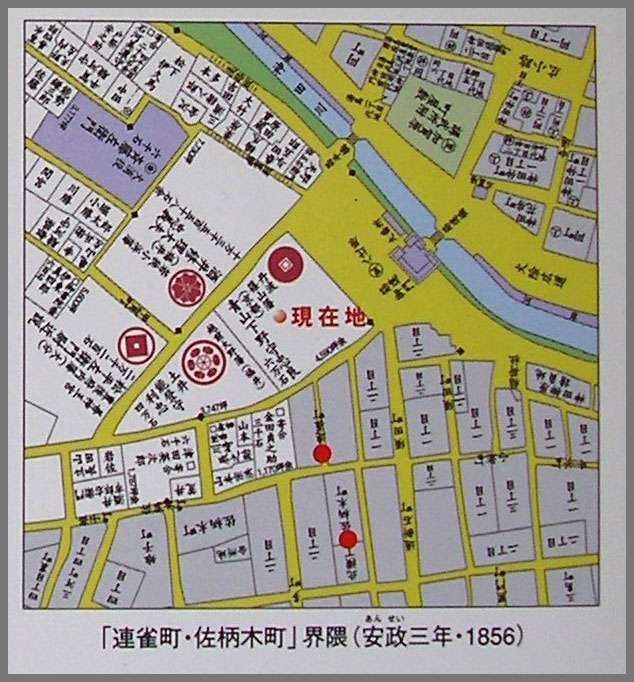[ . BACK to DARUMA MUSEUM TOP . ]
. Famous Places and Powerspots of Edo 江戸の名所 .
::::::::::::::::::::::::::::::
Senju 千住 Senju district
千住 Senju, "one-thousand homes" - the local people call the place "Senji".

千住の大はし Great bridge at Senju
Utagawa Hiroshige
Since traffic passing Senju was busy since the early Edo period, Tokugawa Ieyasu allowed a large bridge to be built over the river 隅田川 Sumidagawa in 1594. It was about 200 meters more upstream than the bridge is now, and the postal station 千住宿 Senju-Shuku was on the North side of the bridge (Kita Senju). Most Daimyo stayed here on their way in and out of Edo, heading North. Providing fresh food for the many travellers was important.
Along the river where also lumber yards, storing the lumber coming downriver in rafts from Chichibu.
Kita-Senju 北千住 North-Senju
Minami-Senju 南千住 South-Senju
- quote -
Adachi-ku, Senju / Arakawa-ku, Minamisenju
Description
There are several theories for the origin of the area name, some say it is related to the 千手 senju (thousand hand) Kannon statue that was located at 勝専寺 Shosen-Ji Temple,
and others say it was related to the fact that the Chiba clan lived there (In Japanese the first character of the name 千葉 "Chiba" can be read as "sen" and "ju" can mean lived, so this could mean something like "place where the Chiba clan lived").

千住花街眺望ノ不二 - Senju kagai yori chobo no Fuji
Katsushika Hokusai
This was the first post station on the Nikko-kaido Road (Oshu-kaido Road) and one of the 4 posting stations of Edo. In 1594 the Senju-ohashi Bridge was constructed on the Arakawa-river (present day Sumida-gawa River), and the area developed as an important place for transportation and travel in conjunction with the construction of the mausoleum of Tokugawa Ieyasu and Tokugawa Iemitsu in Nikko in 1625.
From the Kyoho Era (1716-36) onward, morning markets were held every day in the やちゃば "yacchaba" (yatchaba) within the posting stations, and were as popular as the fish markets of Nihonbashi. The area also supposed Edo's prosperity through water transport as a stopping point on the Kawagoe yofune (Kawagoe evening ships) which linked Kawagoe and Edo in a single evening and transported tourists as well as grain, fuel and fresh fish.
There was an execution ground in Kozukahara on the southern coast, which was known as the area where Sugita Genpaku and Maeno Ryotaku attended the autopsies of executed criminals in 1771.
In 1667, the Ekoin Temple was established in order to hold memorial services for those who died while in prison or who were executed.
- source : ndl.go.jp/landmarks/e...
. Kozukahara, Kozukappara keijō 小塚原刑場 Kozukappara execution grounds .
located near the southwest exit of Tokyo's Minami-Senju Station. ...
and
kubikiri Jizoo 首切り地蔵 Jiso Bosatsu to help the beheaded
There is also a theory about a beauty named 千寿 Senju ("A thousand long lives"), mistress of 足利義政 Shogun Ashikaga Yoshimasa (1436 - 1490), who was born in a village here, thus later giving her name to the place.

千住大橋 Senju Ohashi Bridge - - 江戸名所図会 Edo Meisho Zue
..............................
Senjuunegi, Senjuu negi 千住葱 leek from Senju, Senjunegi 千寿葱
They are best when simply grilled over charcoal.

::::::::::::::::::::::::::::::
Kita Senju 北千住 "North-Senju"

source : tomochika0430
Senju shuku 千住宿
first stop on the Oshu Dochu and Nikko Dochu 奥州道中 - 日光道中
. Edo shishuku 江戸四宿 The four most important SHUKUBA out of Edo .
..............................
. tsukegi no ema 北千住 付け木の絵馬 votive tablet on a wooden frame .
made at the shop Yoshidaya 吉田家
::::::::::::::::::::::::::::::
- - - - - H A I K U and S E N R Y U - - - - -
行く春や鳥啼き魚の目は泪
yuku haru ya tori naki uo no me wa namida
spring is leaving ..
birds sing and the eyes of fish
are full of tears
Basho at Senju 千住 in 1689, taking final leave from his friends.
Departure 千住 江戸、旅立ち . 3月37日 (now May 16)
. Matsuo Basho, Oku no Hosomichi 奥の細道 .
..............................
. Takebe Soochoo 建部巣兆 Takebe Socho (1761-1814) .
He was one of the leading haiku poets of Edo during his time, together with Suzuki Michihiko 鈴木道彦 and Natsume Seibi 夏目成美.
He was a famous resident of the Senju 千住 district.
..............................
. Kobayashi Issa in Edo 小林一茶 .
早立は千住留りか帰る雁
haya tatsu wa Senju-domari ka kaeru kari
::::::::::::::::::::::::::::::

- - - To join me on facebook, click the image !
::::::::::::::::::::::::::::::
. Famous Places and Powerspots of Edo 江戸の名所 .
. Doing Business in Edo - 商売 - Introduction .
. shokunin 職人 craftsman, craftsmen, artisan, Handwerker .
. Edo bakufu 江戸幕府 The Edo Government .
. Japanese Architecture - Interior Design - The Japanese Home .
. Legends and Tales from Japan 伝説 - Introduction .
[ . BACK to DARUMA MUSEUM TOP . ]
[ . BACK to WORLDKIGO . TOP . ]
- - - - - #senju #kitasenju - - - -
::::::::::::::::::::::::::::::
--
Posted By Gabi Greve to Edo - the EDOPEDIA - on 7/02/2017 10:58:00 am








































